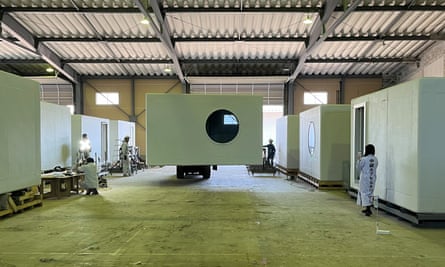Tatsuyuki Maeda had more reason than most to feel a pang of regret as he joined admirers and passing office workers to watch Nakagin Capsule Tower being dismantled.
The building was not just one of Tokyo’s most famous structures; for more than a decade it had been Maeda’s occasional home – a pied-à-terre in the heart of the city he had coveted since he first set eyes on it from his nearby workplace.
Its creator, the celebrated architect Kisho Kurokawa, had intended for the capsules to be removed and replaced every 25 years at the end of what he saw as their natural life cycle – an innovation rendered impracticable by a design fault that made it next to impossible to remove single pods.
In 2021, as the building neared its half century, the ravages of time, coupled with disagreements among owners over its future, helped seal Nakagin’s fate. The capsules, originally painted white, had become discoloured, and netting had to be installed to keep dislodged rust fragments from falling on to the street. There was concern about the large quantities of asbestos inside the building, which no longer met Japan’s strict earthquake-resistance regulations.
After the management company and capsule owners agreed to sell the plot, work began last April to remove the asbestos, rip out the pods’ interiors and demolish the building.

“I have an office nearby, so I went out and took some photos when they started taking it apart,” Maeda, who owned 15 of the pods, said. “We weren’t able to save all of the capsules, but we were determined to spare at least some of them.”
The 55-year-old had already started making plans to secure the tower’s architectural legacy after conceding that the 13-storey building would not survive in its original form. He leased some of his pods and conducted guided tours to raise money.
Built in 1972, Nakagin was an architectural curiosity tucked away in a corner of the city’s Ginza district – an asymmetric stack of 140 identical concrete boxes that became home to a community of artists and designers, and ordinary tenants who could not face long weekday commutes home to the suburbs.
From the outside, the capsules resembled giant washing machines, complete with a single circular window and a blind that fanned out to shield their occupants from the glare of the city lights. Each 10-sq metre space came with a unit bathroom, a Sony Trinitron TV, a reel-to-reel cassette player and a rotary dial phone.
The tower was an early example of metabolism, an avant garde architectural movement formed in Japan in the late 1950s whose disciples viewed buildings as organisms that could be adapted or removed over time. For Kurokawa and his fellow metabolists, architecture needed to accommodate the radical changes Japan was undergoing during its postwar economic and cultural transformation.

Maeda and other members of the nonprofit Nakagin Capsule Tower preservation and regeneration project saved 23 capsules, which now sit in a warehouse in Chiba prefecture, near Tokyo.
Fourteen are being restored to their original state, complete with the electric appliances and unit bath – although not all of the retro gadgets are in working order – while the remaining nine are being stripped down to their basic structure, giving prospective owners a blank canvas on which to design a new interior.
Maeda expects some of the restored units to appear in hotel and company lobbies and museums, although talks with potential owners are still in the early stages. He has also received inquiries from Asia, Europe and the US, but would say only that an agreement had been reached with an entity in Germany.
“And at some point next year it will be possible to see one of these pods in its original state somewhere in Japan,” he said, adding that restoration work is now in the final stages.
Nakagin in its original form gained legions of admirers from around the world, featured in films and as a backdrop to fashion shoots, and became a must-see for tourists intrigued by a building whose appeal only increased as it grew more incongruous with its surroundings.

Nakagin Capsule Tower is no longer, but Maeda is confident the restoration project honours the spirit of its creator. “Kurokawa intended for the capsules to adapt and change over time, depending on the environment, and if you think about it, this is exactly what is happening,” he said.
If the project succeeds, the reborn pods will be scattered across the world, as attractions in museums and corporate lobbies or as holiday accommodations. Maeda may even save one for himself. “If one of the pods is left, then I could see myself putting it in a forest, or even inside my house,” he said. “But if that’s not possible, I’ll be happy just to be able to watch over them.”

 1 year ago
91
1 year ago
91










 English (US)
English (US)